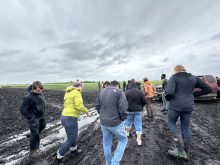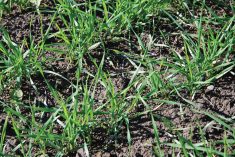Hawaii — the name conjures up thoughts of beautiful beaches, waterfalls, fresh exotic fruits, flowers. However, there is a much darker side that most tourists are unaware of — an atmosphere of distrust, vandalism, legal wars, massive security, heartbreak and so much more. All of this due to genetically modified (GM) crops.
With a 12-month growing season, Hawaii is a mecca for crop-breeding programs. All of the large agricultural companies have operations on several islands. Corn, soybeans and papaya are the main GM crops grown, although research is currently being done on bananas, pineapple and lettuce. Over the last few years though, Hawaii has become Ground Zero of the war over GM crops.
Read Also

Manitoba sclerotinia picture mixed for 2025
Variations in weather and crop development in this year’s Manitoba canola fields make blanket sclerotinia outlooks hard to pin down
Over the past two years, the counties (islands) of Kauai, Hawaii, and Maui have passed laws restricting the use of GM plants. The laws differ slightly. Kauai’s ban included restrictions on where any pesticides could be sprayed, but yet excluded GM papaya. The County of Hawaii’s ban excluded all future GM crops on the island and required that all farmers must register their fields of existing GM crops. Violators would be fined $1,000 per day.
Currently the laws in Hawaii and Kauai have been overturned by courts. The moratorium in Maui, which calls for a complete stop to the cultivation of any GM crop until studies conclusively prove it is safe and sets fines at $50,000 per day for farmers who knowingly grow GM crops, is under appeal.
Papaya virus
GM technology has been used since the mid-1990s in Hawaii, and is credited with saving the state’s papaya industry, following the arrival of the papaya ringspot virus (PRV) in the 1980s. Once a plant is infected with PRV, it can never recover, and another papaya can never be planted on the same spot. Transmitted by aphids, the virus quickly kills young seedlings, while older trees turn yellow and die a slow death, producing smaller and smaller fruit.
Dennis Gonsalvez is credited as the “saviour of the papaya industry.” In the late 1970s, as a young plant virologist at Cornell University, Gonsalves realized that PRV had the potential to decimate all papaya trees and began research on a solution.
His initial approach was to try to vaccinate the papayas, but the system required every seedling to be injected which was incredibly cumbersome. Finally, in 1991, Gonsalves successfully modified the fruit with a specific protein gene enabling resistance to the virus. Although it took over nine years to pass through the various U.S. levels of approval, the Rainbow papaya was the first GM horticultural crop.
“Rainbow” papaya now makes up about 77 per cent of the crop, although the industry is much smaller than it was before the virus hit. According to the Hawaiian Department of Agriculture, in 2010, 30.1 million pounds of papaya were harvested, compared to 80.5 million pounds in 1984.
Ken Kamiya, a second-generation papaya farmer from Oahu, remembers the days of the virus. “We got completely wiped out. We were cutting down trees every week, but the only option for replanting was to find virgin ground, and we ran out of that pretty quickly.”
Kamiya, a longtime friend of Gonsalvez, credits GM papaya for saving his farm. Since Hawaii is a net food importer, Kamiya views his land as critical for the assurance of local food supply. “I’ve had customers who have been with me for close to 40 years. They know me and my family, and realize that we’re doing our best.”
Vandalism
Kamiya finds it disheartening to see the current backlash against agriculture, science, and especially biotechnology. “Our community is divided, the conversations can quickly turn ugly and there’s a definite lack of respect and trust for us farmers.”
The hostility is to the point that several papaya farmers have awoken in the morning to find that their entire acreages were chopped down by vandals in the night.
All of the papaya farmers in the state pay a self-imposed levy for research, and Kamiya believes that scientists in both corporations and universities are necessary for continued advancement. “We need all the tools in our tool box. With the papaya virus, there are no other tools except for GM.”
When asked about the future of GM crops, both Gonsalvez and Kamiya wonder why, after 25 years, papaya remains the only GM horticultural plant to be commercialized. Aside from the cost, Gonsalvez suggests that “most horticultural biotech research has been done in the public sector by those lacking skills in commercialization.”
He also believes that science needs to be doing more to commercialize transgenics for smaller crops, those which can truly benefit Third World countries. “Think of the benefit that GM cassava could have in Uganda, for example. And we already know that Golden Rice (high in vitamin A) has the potential to improve the health of millions of people.”
Ultimately, the now 77-year-old Gonsalvez remains excited about the potential of GM technology. “It’s the one way we can beat the diseases impacting our food supply. There’s no such thing as a viricide, so we must use gene technology and resistance as tools.”



















